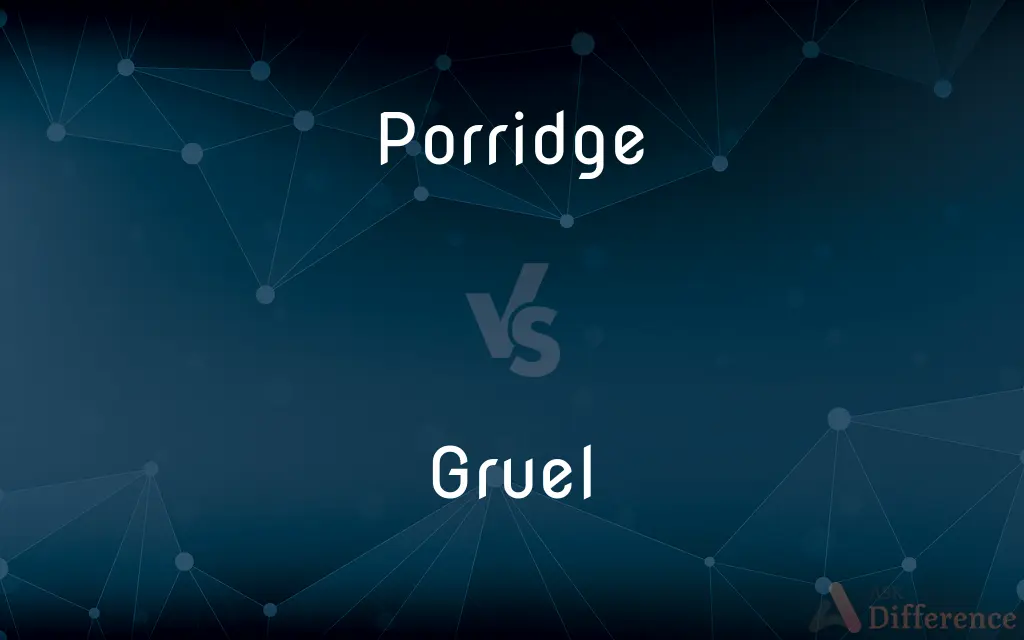Porridge vs. Gruel — What's the Difference?
Edited by Tayyaba Rehman — By Maham Liaqat — Updated on March 9, 2024
Porridge is a thick, hearty dish made by boiling grains in milk or water, often served warm. Gruel is a thinner, more liquid-like cereal made by boiling grains in water or milk, typically less hearty than porridge.

Difference Between Porridge and Gruel
Table of Contents
ADVERTISEMENT
Key Differences
Porridge is a traditional breakfast dish in many cultures, made from oatmeal, cornmeal, rice, or other grains boiled in water or milk until it reaches a thick consistency. It is often enriched with ingredients like sugar, honey, fruits, or nuts to add flavor and nutritional value. On the other hand, gruel is much thinner, resembling a soupy consistency, and is made by boiling ground grains in water or milk. Gruel is historically associated with poverty or famine, serving as a basic sustenance food with minimal nutritional content.
While porridge is generally considered a nutritious and filling meal, often eaten to start the day with energy, gruel is seen as a less desirable option due to its watery texture and lower calorie content. Porridge's versatility allows for a wide range of dietary preferences and nutritional needs, accommodating various additions to enhance its taste and health benefits. Conversely, gruel's simplicity and lack of thickness make it less likely to be consumed for pleasure and more for basic nourishment or dietary necessity.
The cooking process for porridge typically involves simmering the grains for a longer period, allowing the mixture to thicken and flavors to develop fully. This results in a creamy, rich texture that can be adjusted according to personal preference by altering the cooking time or the ratio of liquid to grains. Gruel, however, is cooked for a shorter time or with a higher liquid-to-grain ratio, leading to its characteristic thin consistency. This makes gruel a quicker and easier preparation, but with less texture and flavor complexity than porridge.
Porridge holds a place in many traditional cuisines, celebrated for its comfort food qualities and ability to be adapted to local tastes and ingredients. It is often associated with warmth, nourishment, and family. Gruel, by contrast, does not typically enjoy the same positive cultural connotations, though it has been a vital part of diet in times of scarcity or when cooking facilities and ingredients were limited.
Despite their differences, both porridge and gruel serve important dietary roles, providing basic sustenance and, particularly in the case of porridge, the possibility for a nutritious meal that supports a healthy lifestyle. The choice between them can depend on individual health needs, available resources, and personal taste preferences.
ADVERTISEMENT
Comparison Chart
Consistency
Thick and creamy
Thin and watery
Ingredients
Grains boiled in milk or water, often with added flavors
Grains boiled in water or milk, usually without added flavors
Nutritional Value
High, with potential for added nutrients from ingredients
Lower, primarily basic sustenance
Cooking Time
Longer, to achieve thickness
Shorter, resulting in a thinner consistency
Cultural Significance
Often associated with comfort and nourishment
Historically linked with poverty and basic sustenance
Compare with Definitions
Porridge
Often enriched with proteins, vitamins, and minerals.
Quinoa porridge is a protein-rich alternative to oatmeal.
Gruel
Lacks the richness and added ingredients found in porridge.
Water and rice can be boiled into a simple gruel for a minimalist meal.
Porridge
A thick, nutritious meal made from boiled grains.
Oatmeal porridge topped with fresh fruit and honey is a popular breakfast.
Gruel
A thin, liquid meal made from boiled grains.
Gruel was commonly eaten during historical periods of food scarcity.
Porridge
A dish with various cultural adaptations and significance.
In Scotland, traditional porridge is made with salt and water.
Gruel
Made with a higher water-to-grain ratio.
In many cultures, gruel is prepared quickly as a basic form of nourishment.
Porridge
Can be customized with numerous ingredients for flavor and nutrition.
Rice porridge, or congee, is often served with savory toppings in Asia.
Gruel
Associated with poverty and minimal living conditions.
Literature often depicts gruel as the meager fare of orphans and the impoverished.
Porridge
Known for its warming and satisfying qualities.
On cold mornings, a bowl of warm porridge provides comfort and energy.
Gruel
Often consumed out of necessity rather than preference.
Patients with difficulty swallowing may be fed gruel for its easier consumption.
Porridge
Time spent in prison
I'm sweating it out doing porridge
Gruel
Gruel is a food consisting of some type of cereal—such as ground oats, wheat, rye or rice—boiled in water or milk. It is a thinner version of porridge that may be more often drunk rather than eaten and may not need to be cooked.
Porridge
Porridge is a food commonly eaten as a breakfast cereal dish, made by boiling ground, crushed or chopped starchy plants—typically grain—in milk. It is often cooked or served with added flavourings such as sugar, honey, (dried) fruit or syrup to make a sweet cereal, or it can be mixed with spices, meat or vegetables to make a savoury dish.
Gruel
A thin watery porridge.
Porridge
A dish consisting of oatmeal or another meal or cereal boiled in water or milk.
Gruel
Chiefly British Severe punishment.
Porridge
A soft food made by boiling oatmeal or another meal in water or milk.
Gruel
A thin, watery porridge, formerly eaten primarily by the poor and the ill.
Porridge
A dish made of grain or legumes, milk and/or water, heated and stirred until thick and typically eaten for breakfast.
Eat your porridge while it's hot!
Gruel
Punishment
Porridge
Oatmeal porridge.
Gruel
Something that lacks substance
Thin gruel
Porridge
Rice porridge; congee.
Gruel
Sentimental poetry
Porridge
A prison sentence.
Just do your porridge and keep your head down.
Gruel
Semen
Porridge
(rare) A type of thick soup or stew, especially thickened with barley.
Gruel
(transitive) To exhaust, use up, disable
Porridge
A food made by boiling some leguminous or farinaceous substance, or the meal of it, in water or in milk, making of broth or thin pudding; as, barley porridge, milk porridge, bean porridge, etc.
Gruel
(transitive) to punish en
Porridge
Soft food made by boiling oatmeal or other meal or legumes in water or milk until thick
Gruel
Ejaculate
Gruel
A light, liquid food, made by boiling meal of maize, oatmeal, or flour in water or milk; thin porridge.
Gruel
A thin porridge (usually oatmeal or cornmeal)
Common Curiosities
Is porridge healthier than gruel?
Generally, porridge is considered healthier due to its higher nutritional content and ability to incorporate various nutritious ingredients.
Can any grain be used to make porridge or gruel?
Yes, a variety of grains can be used for both, including oats, rice, cornmeal, and barley, depending on regional preferences and availability.
Why is gruel associated with poverty?
Historically, gruel has been a food of last resort due to its simple, inexpensive ingredients and minimal nutritional value, often consumed during times of scarcity.
Is gruel still commonly eaten today?
While less common in affluent societies, gruel is still consumed in various forms worldwide, especially in situations requiring easily digestible meals.
How did porridge gain its cultural significance?
Porridge has been a staple food in many cultures for centuries, valued for its warmth, nourishment, and the ease of incorporating local ingredients, thus becoming deeply ingrained in tradition.
What are the main differences between porridge and gruel?
The main differences are consistency, ingredients, and nutritional value; porridge is thicker and more nutritious, often with added ingredients, while gruel is thinner, simpler, and less nutrient-dense.
How can I make porridge more flavorful?
Adding fruits, nuts, honey, spices, or even savory ingredients like cheese or vegetables can enhance the flavor of porridge.
Are there any modern variations of gruel?
Modern dietary trends and necessity have led to variations of gruel that include more nutritious ingredients or are tailored to specific health needs, though these are not typically referred to as gruel.
Was gruel ever considered a staple food?
Yes, in times and places where food was scarce or cooking facilities were limited, gruel served as a basic staple for sustenance.
Can porridge be part of a weight-loss diet?
Yes, when made with water or low-fat milk and without adding excessive sugars, porridge can be a filling, low-calorie option that supports weight loss.
Share Your Discovery

Previous Comparison
Continue vs. Resume
Next Comparison
Login vs. PasswordAuthor Spotlight
Written by
Maham LiaqatEdited by
Tayyaba RehmanTayyaba Rehman is a distinguished writer, currently serving as a primary contributor to askdifference.com. As a researcher in semantics and etymology, Tayyaba's passion for the complexity of languages and their distinctions has found a perfect home on the platform. Tayyaba delves into the intricacies of language, distinguishing between commonly confused words and phrases, thereby providing clarity for readers worldwide.
















































